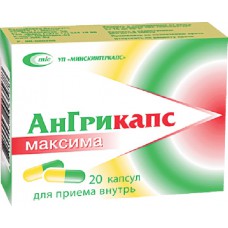Expiration date: 12/2026
Composition and form of issue:
Capsules. 1 capsule contains active substance:
paracetamol 180 mg
rimantadine hydrochloride 25 mg
ascorbic acid with SC-type coating (silicone coating) - based on ascorbic acid 150 mg
loratadine 1, 5 mg
rutin 10 mg
calcium carbonate 11, 2 mg
(in terms of calcium-4, 48 mg)
auxiliary substances: calcium stearate — 4, 5 mg potato starch 15 mg lactose a sufficient quantity to obtain the contents of the capsule with a mass of 450 mg
the composition of the shell capsules: gelatin pharmaceutical — 80, 37 mg of glycerol — 0, 413 mg of methyl parahydroxybenzoate — 0, 355 mg of parahydroxybenzoate — 0, 086 mg of sodium lauryl sulfate — a 0 058 mg titanium dioxide — 1, 354 mg purified water — 12, 99 mg dyes: quinoline yellow E-104 — 0, 079 mg "sunset" yellow E-110 — 0, 029 mg brilliant blue E-133 — 0, 267 mg
in a contour cells packing (blisters) 10 PCs per cartons 2 packages (blister)
Description of dosage form:
Solid gelatine capsules No. 0, the body is yellow and the top green.
The contents of the capsules-light yellow with a greenish or cream tint powder.
Pharmacokinetics:
The pharmacokinetics of the combined drug has not been studied.
Description of pharmacological action:
The pharmacological activity of a medicine Angricaps maxima is caused by complex action of its ingredients — paracetamol, rimantadine, ascorbic acid, loratadine, rutin and calcium.
The drug has an antiviral, antipyretic, analgesic, antihistamine, angioprotective effect.
Paracetamol has analgesic and Arapongas action.
Rimantadine is an antiviral agent derived from adamantane. Active against various strains of influenza a virus. Suppresses the early stage of a specific reproduction (after the virus has entered the cell and before the RNA transcription). Rimantadine inhibits the release of viral particles from the cell, i.e. interrupts the transcription of the viral genome.
Ascorbic acid is involved in many redox reactions, increases the body's resistance to infections.
Loratadine-blocker of H1-histamine receptors of long-term action. Prevents the development of tissue edema associated with the release of histamine. It has antiallergic, antipruritic and protivoekssoudative action.
Calcium prevents the development of increased permeability and fragility of blood vessels, has a membrane stabilizing effect.
Rutin is a angioprotectors. Prevents the development of increased permeability and fragility of blood vessels, causing hemorrhagic processes in influenza. Rutozid together with ascorbic acid is involved in oxidation-reduction processes, has antioxidant properties, prevents oxidation and promotes the deposition of ascorbic acid in tissues.
Indications:
Symptomatic treatment of influenza A.
Contraindications:
- hypersensitivity to one or more components of the drug
- pregnancy and lactation
- the age of 18
- lactose intolerance, lactase deficiency, glucose-galactose malabsorption.
With caution: renal and hepatic insufficiency, renal stone disease, benign hyperbilirubinemia (including Gilbert's syndrome), viral hepatitis, alcoholic liver damage, old age, epilepsy (including history), sideroblastic anemia.
Side effect:
CNS: rarely — headache, fatigue, irritability, dizziness, tremor, hyperkinesis.
On the part of the gastrointestinal tract: if the duration of more than 7 days may damage the mucous membrane of the stomach and duodenum, dyspepsia, dry mouth, nausea, anorexia, flatulence, diarrhea.
On the part of the blood system: the duration of more than 7 days-agranulocytosis, leukopenia, thrombocytopenia, neutropenia, anemia.
Allergic reactions: rarely - possible skin rash, itching, hives.
Drug interaction:
If you need to share with other drugs previously consult with your doctor.
It is recommended to avoid simultaneous use with glucocorticoid drugs, hepatotoxic and anticonvulsant agents, barbiturates, anticoagulants, rifampicin, alcohol.
Was diflunisal increases the plasma concentration of paracetamol on 50% — risk of hepatotoxicity.
Myelotoxic drugs increase the manifestations of hematotoxicity of paracetamol included in the drug.
Metoclopramide increases the absorption of paracetamol when combined.
Ascorbic acid increases the blood concentration of penicillin and tetracyclines improves the intestinal absorption of iron supplements (converts ferric iron to ferrous). Increases the risk of crystalluria in the treatment of salicylates and sulfonamides of short-acting, inhibits the excretion of kidney acids, increases the excretion of drugs with an alkaline reaction (including alkaloids), reduces the concentration of oral contraceptives in the blood. Reduces the therapeutic effect of antipsychotic drugs (neuroleptics) — phenothiazine derivatives, tubular reabsorption of amphetamine and tricyclic antidepressants.
CYP3A4 inhibitors (including ketoconazole, erythromycin), CYP3A4 and CYP2D6 inhibitors (cimetidine, etc.) increase the concentration of loratadine in the blood.
The effect of rutin is enhanced by ascorbic acid.
Calcium carbonate slows down the absorption of tetracyclines, digoxin, oral iron preparations (the interval between their doses should be at least 2 hours). When combined with thiazide diuretics may increase hypercalcemia, reduce the effect of calcitonin in hypercalcemia, reduce the bioavailability of phenytoin.
Dosage and administration:
Inside, after eating, drinking water.
Adults-2 caps. 2-3 times a day for 3-5 days, until the symptoms of the disease disappear.
If there is no improvement in the state of health, the drug should be stopped and consult a doctor!
Overdose:
Symptoms: in the first 24 hours may pale, nausea, vomiting and pain in the epigastric region, tremor, drowsiness, tachycardia, increase in bilirubin in the blood, exacerbation of concomitant chronic diseases. Symptoms of liver dysfunction may appear after 12-48 hours after an overdose (paracetamol). In severe overdose-liver failure with progressive encephalopathy, coma, death, acute renal failure with tubular necrosis (including in the absence of severe liver damage), arrhythmia, pancreatitis.
Treatment: induction of gag reflex, gastric lavage, adsorbent intake, symptomatic therapy.
It is necessary to consult a doctor.
Special instruction:
Duration of application-no more than 5 days. During treatment, you should abandon the use of alcoholic beverages (increased risk of gastrointestinal bleeding). With long-term use (over 7 days) may exacerbate chronic concomitant diseases in elderly patients with hypertension increases the risk of hemorrhagic stroke (due to the drug rimantadine).
When receiving increases the risk of liver damage in patients with alcoholic hepatosis. Distorts the performance of laboratory studies in the quantitative determination of glucose and uric acid in plasma (paracetamol).
Due to the stimulating effect of ascorbic acid on the synthesis of glucocorticosteroid hormones, it is necessary to monitor the function of the adrenal glands and blood PRESSURE. Ascorbic acid as a reducing agent can distort the results of various laboratory tests (blood glucose, bilirubin, liver transaminase activity and lactate dehydrogenase).
Do not use in the presence of metastatic tumors.
Be careful when driving and occupation of other potentially hazardous activities, require high concentration and psychomotor speed reactions (includes rimantadine).


